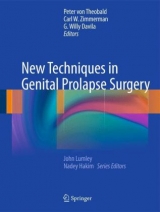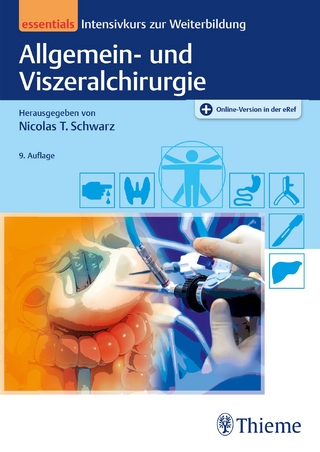New Techniques in Genital Prolapse Surgery
Springer London Ltd (Verlag)
978-1-84882-135-4 (ISBN)
- Titel ist leider vergriffen;
keine Neuauflage - Artikel merken
Approximately 11% of women have undergone surgery for a genital prolapse by the age of 80 and these procedures are now among the most common and frequent operations in females after hysterectomy and c-section. As life expectancy increases and as patients demand a higher quality of life, the number of patients (and surgeons) concerned with this issue is growing. Many of the common techniques for prolapse repair are unchanged since the end of the 19th century when most of the techniques were established. If the 80's and 90's were the years of the laparoscopic surgery revolution, the new millennium has started with the urogynaecologic surgery revolution, but there is a difference. While laparoscopic surgery was trying to mimic the same techniques as traditional surgery through a new approach, the new prolapse surgery is trying to modify dramatically the traditional techniques through the same incision. Application of mesh to other areas of surgery for prolapse repair was a logical consequence of the success of TVT and SUI (Tension-free Vaginal Tape and Stress Urinary Incontinence) surgery.
Mesh procedures started becoming popular in the new millennium and aimed to be less invasive and more efficient than the traditional techniques. After 5 years of evolution, standardized techniques have emerged for cystocele repair, vault prolapse suspension, and enterocele and rectocele repair. A high interest for these new techniques is shown by all pelvic floor surgeons including those who were the pioneers of the procedures, those already using these techniques, those who are still afraid to use them, and those who are hostile because of allegiance to the technique of plication. Surgeons need information about mechanically superior anatomically restorative pelvic organ prolapse procedures. Most of the papers published in the concerned journals (IUJ for example) are on this subject, but to date, no book has been published. It is time now for a well-researched title containing simple, practical, and useful information written by international experts in this field.
PART I Anatomy and Function.- New Considerations about Pelvic Floor Anatomy.- New Directions in Restoration of Pelvic Structure and Function.- Hernia Principles: What General Surgeons Can Teach Us about Prolapse Repair.- Diagnosis of Uterovaginal Support.- Complementary Investigations.- PART II: The Grafts.- The Principles of Mesh Surgery.- Properties of Synthetic Implants Used in the Repair of Gential Prolapses and Urinary Incontinence in Women.- Medium Term Anatomical and Functional Results of Laparoscopic Sacrocolpopexy Using Xenografts.- Free or Fixed Implants?.- A Comparative Analysis of Biomaterials Currently Used in Pelvic Reconstructive Surgery.- PART III: Anterior Defect Repair.- Cystocele Repair with Mesh (Fixed Implant).- Coexisting Cystocele and Stress Urinary Incontenence: Sequential or Concomitant Surgical Approach?.- Simultaneous Repair of Stress Urinary Incontenence (SUI) with the Cystocele Mesh.- PART IV: Mid-Compartment Repair.- Surgical Mesh Reconstruction for Post-hysterectomy Vaginal Vault Prolapse.- Is Hysterectomy Necessary to Treat Genital Prolapse?.- Uterine Prolapse Repair with Meshes.- Anterior and Posterior Enterocele.- PART V: Posterior Compartment Repair.- Treatment of Posterior Vaginal Wall Defects.- Rectal Intussusception: Can Posterior IVS Be the Cure?.- PART VI: Complications.- 20. Exposure and Erosion of Vaginal Meshes: Etiology and Treatment.- Recurrence in Prosthetic Surgery.- Postoperative Infections in Pelvic Reconstructive Surgery.- Rectal Complications of Mesh Repairs.- Sexual Function after Mesh Repairs.- PART VII: Future.- Reinforcement Materials in Soft Tissue Repair: Key Parameters Controlling Tolerance and Performance-Current and Future Trends in Mesh Development.- Internal Fixation and Soft Tissue Anchors for Prolapse Repair.- Future Challenges.- The Future of Pelvic Organ Prolapse (POP)Surgery.
| Erscheint lt. Verlag | 1.4.2010 |
|---|---|
| Reihe/Serie | New Techniques in Surgery Series ; v. 5 |
| Zusatzinfo | biography |
| Verlagsort | England |
| Sprache | englisch |
| Maße | 210 x 279 mm |
| Gewicht | 1051 g |
| Einbandart | gebunden |
| Themenwelt | Medizinische Fachgebiete ► Chirurgie ► Viszeralchirurgie |
| Medizin / Pharmazie ► Medizinische Fachgebiete ► Gynäkologie / Geburtshilfe | |
| ISBN-10 | 1-84882-135-2 / 1848821352 |
| ISBN-13 | 978-1-84882-135-4 / 9781848821354 |
| Zustand | Neuware |
| Haben Sie eine Frage zum Produkt? |
aus dem Bereich




